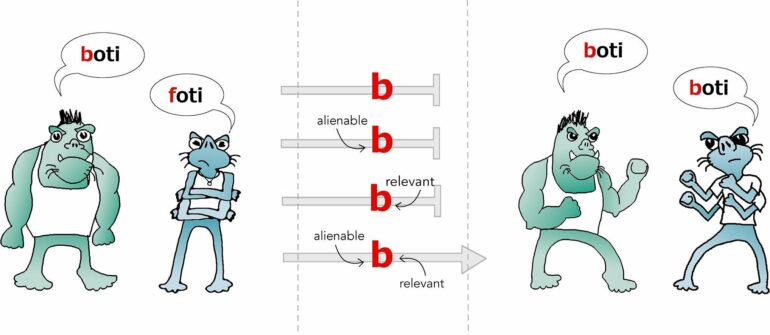You can learn a lot about an animal by how it communicates. Birds tweet melodies to attract mates and defend their territory. Dogs befriend each other with wagging tails and smelly pheromones. Even plants communicate by diffusing chemicals through the soil, networking with the root systems of the flora around them.
For Gareth Roberts, studying linguistics is a way to learn more about humans. “I’ve always been interested in language,” says Roberts, an associate professor of linguistics in Penn’s School of Arts & Sciences. Raised in a bilingual community in Wales, he spoke both English and Welsh from a young age and went on to pick up even more languages as a teenager and at the University of Nottingham, where he studied German and Russian. He lived in both Russia and Germany for a time and taught English, considering becoming an interpreter. “But,” he says, “it became increasingly clear that what I was really interested in was just how language works.”
Roberts now directs the Cultural Evolution of Language Lab, where he uses experimental techniques like artificial languages and interactive games to explore how social pressures shape language over time.
“Language evolves, and it evolves to the brains and social structures of the humans who use it,” he says. “We can investigate this by bringing miniature languages into the lab and doing experiments on them.”
These miniature languages can include anywhere from two to 20 new words with variable endings and different dialects. This approach, sometimes called experimental semiotics, allows linguists to study language learning and evolution in a structured setting, akin to how researchers in the biological sciences use model organisms like fruit flies or mice for their easily manipulated genetic systems and fast reproductive cycles.
“We get control over things we can’t control in the real world, and we get to see language change fairly rapidly,” Roberts says.
In addition to using artificial languages, Roberts often builds games that feature player-to-player dialogue, stylized alien creatures, and even fighting. By manipulating the linguistic features that are associated with particular social traits of the “alien” languages—like a certain suffix being linked in players’ minds with a certain personality trait—Roberts can see how social factors influence language evolution.
Social biases
One avenue of research in the lab concerns how social biases can hinder effective communication. “There can be this tension between the social pressures on language and how successfully you communicate the statements you want to communicate,” Roberts says.
One real-world example of this is the choice between the words “you” and “y’all.” In English, “you” can refer to both one person or a group of people, making its meaning ambiguous. The word “y’all” on the other hand removes that ambiguity by specifically referring to a group.
Roberts says that, if language was concerned solely with precision, usage of “y’all” would be more widespread and perhaps even more prestigious, similar to how “whom” has a more distinguished connotation than “who.” But in reality, Roberts says, “because we happen to have social associations with ‘y’all’—that it’s somehow more lower-class or less prestigious—people tend not to use this form in certain contexts.” In other words, the social biases against “y’all” outweigh the value of its precision.
Roberts, together with collaborators Masha Fedzechkina and Lucy Hall Hartley at the University of Arizona, mimicked this effect of social pressure using an artificial language in a study published last year in Language Acquisition. In the experiment, participants were introduced to two species of aliens, each with their own dialect of the same artificial language. The language included verbs like kyse (kick) and tegut (hug) and nouns like barsa (chef) and pilka (bandit), which could be arranged in multiple, ambiguous orders. One of the alien species’ dialects included suffixes that helped reduce that ambiguity, while the other’s left the meaning unclear.
As participants learned the alien language, they received messages that encouraged them to either to feel the same about the two alien species, or to prefer one over the other. When participants saw messages that made them feel more negatively about the aliens who used the extra, clarifying suffixes, the participants themselves dropped the suffixes in their own writing, even though it came at the cost of obscuring their meaning.
“The social pressure pushed people into a position where they were sharing sentences that were really ambiguous and did not do a good job of communicating the statement they wanted to communicate,” says Roberts. “It may be that social pressures play a very powerful role.”
Games imitate life
The gamelike structure of these alien language experiments sets them apart from traditional psycholinguistic research, says Roberts. For participants, classical psycholinguistic experiments can feel more like a test than a game, with a sometimes-monotonous progression of flashing words and yes-or-no answers. In these experiments, “participants can get quite bored, tired, and perhaps unengaged,” he says.
While these kinds of experiments have formed the foundation of the field and can yield useful results, they don’t always capture the engaging nature of real-world language use. With games, Roberts says, “people tend to be very engaged, and they often care quite a lot about what happens.”
Roberts used one of these games to investigate how and why speakers pick up different dialects in a study published in 2018 in the journal Cognition. In the game, participants played as one of two species of aliens, chatting with each other, and collecting resources by trading, or, in one version of the experiment, by fighting. Each species of alien had its own attributes and dialects: The weak, scrawny Wiwos used more “b” sounds in their speech, whereas the tough, brawny Burls used “f” sounds instead.
Roberts found that, in the experiments where participants could fight to collect resources, the participants—even the ones assigned as weaker Wiwos—started to pick up the dialect of the tougher Burls. The findings, he says, suggest that people tend to borrow linguistic features from groups with traits they value.
These results mirror real-world research by Betsy Sneller, Roberts’ coauthor on the paper and a Penn alumna. In her field research, Sneller found that white, working-class men in South Philadelphia often appropriated a linguistic feature called TH-fronting, where the “th” sound is instead pronounced as “f,” as in “bof” instead of “both.” Sneller argued that the white men adopted TH-fronting—a characteristic feature of African American Vernacular English (AAVE)—to leverage for themselves the toughness and street-smarts they associated with Black men who used AAVE.
Bigger games, better models
Roberts also brings his research techniques to the classroom, where one of his courses combines learning about game theory and experimental games. “They’re not quite the same thing,” he says, “but there’s an interesting commonality between the two. Thinking in terms of games forces you to think about the kind of incentives and goals that drive people.”
Though Roberts’ artificial languages and interactive games have been indispensable research tools, he cautions that, like any scientific model, they’re not perfect. Just as fruit flies or mice are useful but limited model organisms, artificial languages pose their challenges, too.
For Roberts, one of the biggest is designing from scratch languages and games that test for the desired features and control for the rest. “For any experiment, any model, you want to cut out all the stuff that you don’t need, and include all the stuff you do need,” he says. “The difficulty is deciding which is which.”
That challenge isn’t stopping Roberts from developing his experimental techniques even further. In the future, he hopes to run his artificial language experiments for even longer—potentially building languages over weeks or months rather than hours or days—and bring his games out of the lab.
“I’m interested in the possibility of larger-scale experiments, where people take part using an app or on an online experimental platform. For instance, instead of taking part in a one-off 90-minute experiment, people could take part for 10 minutes a week over a period of nine weeks,” he says. This would allow him to see how artificial languages develop over even longer time periods with even more participants. “I think we might learn something from that kind of experiment that we don’t learn from small-scale experiments.”
More information:
Masha Fedzechkina et al, Social biases can lead to less communicatively efficient languages, Language Acquisition (2022). DOI: 10.1080/10489223.2022.2057229
Provided by
University of Pennsylvania
Citation:
What ‘alien’ languages can teach us about real ones (2023, January 19)



